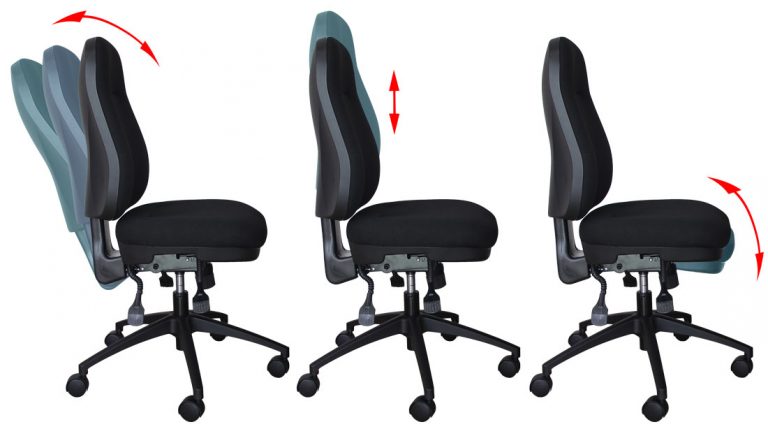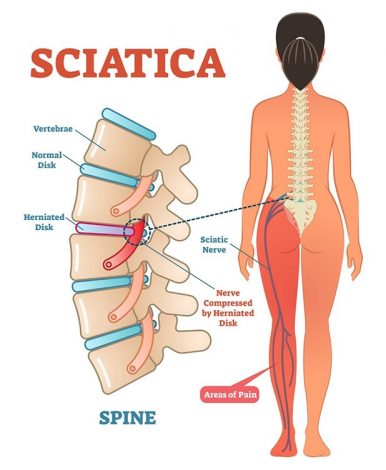- Your cart is empty
- Continue Shopping
What is an Ergonomic Chair?
According to Ergonomic Trends, “an Ergonomic Chair is one that not only follows best practices in terms of proven ergonomic
Do you find that after a day’s work your back aches and your neck and shoulders are stiff and sore? People may tell you that you need an ergonomic or orthopedic office chair to deal with these challenges. What is an orthopedic office chair and how does it differ from its ergonomic counterpart? What is the best chair for medical conditions like sciatica?
Is there really a difference between an ergonomic chair and orthopedic chair? The answer is YES. Unfortunately, many companies use these terms interchangeably to describe their products, thereby creating confusion among consumers.
In this article, we will define both chair types and highlight their differences. Finally, we will provide some guidelines to assist you in selecting the right office chair and deciding which is best for you. Different types of work chair.
An ergonomic chair is designed to optimise support for your body while you sit. The key feature of every good ergonomic chair is that it is highly adjustable. What is an Ergonomic Chair and what makes it special?
Your sitting posture changes throughout the day, and a good chair needs to accommodate these changes by continually supporting your body. Your traditional typist chair with limited adjustability, often resulted in back and other health related problems caused by sitting on a bad chair. Good ergonomic chairs can prevent back, neck and shoulder pain caused by incorrect sitting.
Good ergonomic chairs can prevent back, neck and shoulder pain caused by incorrect sitting.
To achieve this, they should have the following design features:
Orthopedic chairs include all of the above design features of ergonomic chairs. These chairs will therefore also prevent back, neck and shoulder pain caused by incorrect sitting.
However, the main difference between orthopedic and ergonomic office chairs: Orthopedic chairs have a Free-Float Swivel Mechanism.
While ergonomic chairs can prevent back ailments, orthopedic chairs can alleviate the impact of sitting on existing medical preconditions of the lower back.
Orthopedic chairs use a free-float swivel mechanism that allows separate, or independent control of the seat and backrest. This is not possible on a chair fitted with a synchronous swivel mechanism.

Orthopedic chairs have an independent or free-float mechanism that allows the movement of the seat and backrest to be controlled independently.
By independently controlling the angles between the backrest and the seat, orthopedic office chairs may alleviate, and even rehabilitate, certain medical preconditions, specifically musculoskeletal issues of the spine. Medical professionals often endorse orthopedic office chairs.
All orthopedic chairs are also ergonomic chairs, but ergonomic chairs are not necessarily orthopedic chairs!
The free-float mechanism on orthopedic office chairs allows the seat to be adjusted to a forward sloping position. This reduces the disc pressure in the lumbar region of the back. The forward slope, or negative tilt, is typically limited to a maximum of 5 degrees.
By independently controlling the angles between the backrest and the seat, orthopedic chairs may alleviate, and even rehabilitate certain medical preconditions, specifically musculoskeletal issues of the spine. What actually happens when you sit?
In the table below we compare the important differences between orthopedic chairs and ergonomic office chairs.
| Feature | Orthopedic office chair | Ergonomic office chair |
|---|---|---|
| Swivel and Tilt Mechanism | Free-Float mechanism that allows Dynamic Sitting | Synchronous mechanism that allows Dynamic Sitting |
| Seat Foam | Moulded | Moulded |
| May alleviate certain medical preconditions, specifically musculoskeletal issues of the spine like sciatica | Yes | Less likely |
| Seat angle adjustment | Yes, fully independent seat angle adjustment. Lockable in any position. | Synchronous mechanisms have a mechanical link to the backrest. The seat and backrest move together in a fixed ratio. |
| Negative tilt (forward sloping) seat adjustment | Yes | No |
| Backrest angle adjustment | Yes, fully independent backrest adjustment. Lockable in any position | Yes. For synchronous mechanisms, there is a mechanical link to the movement of the seat. |
| Lumbar Support | Yes, integrated with backrest height and angle adjustment | Optional on better ergonomic chairs |
If you have a larger build and need a high-back chair, most standard task chairs will not be suitable for you. Furthermore, if you also have a back-related ailment, not only do you require a heavy duty chair, but also an orthopedic one that provides the correct support for your back.
There are very few office chairs available in South Africa that have both the heavy duty and orthopedic attributes.
The Heathrow is an exception and is a true heavy duty orthopedic office chair.
The mechanism on the Heathrow Heavy Duty Orthopedic Chair allows you to independently adjust the:
.

Sciatica occurs when the sciatic nerve is pinched. It results in pain in the lower back, back of the thighs, and legs. Typically it only affects one leg.
The best chairs for sciatica should have a forward tilting seat and excellent lower back support. In others words, an orthopedic chair is ideal for a medical condition like sciatica.
Before selecting an ergonomic chair or orthopedic chair for your home or office, the first question that needs to be answered is whether or not you have any medical preconditions, specifically musculoskeletal issues of the spine like sciatica. If so, then it is likely that an orthopedic chair will be the better option. If not, then either chair type will be suitable.
Watch this video on how to set up your workstation correctly.
Whether you decide on an ergonomic chair or an orthopedic chair, remember: All chairs are designed for the “average” person, in other words, the majority of people, but not everyone.
For example, a short slim person may find that a standard chair is too high and the armrests are too far apart. In such a case, the chair may need a different height adjuster or armrests that have width adjustment.
To ensure you purchase a chair that’s right for you, contact our team for professional advice.
Selecting the right chair must take the following into consideration:
Still unsure and need help selecting the best chair for you? Visit our showroom and one of our qualified Office Ergonomics Risk Facilitators will conduct a full ergonomic assessment and determine whether an ergonomic or orthopedic office chair is best for you.
According to Ergonomic Trends, “an Ergonomic Chair is one that not only follows best practices in terms of proven ergonomic
Office chairs have an array of levers and knobs to adjust the backrest, seat and armrests. How do you achieve a healthy sitting posture?
Office chairs are made for the “average” person and finding one that provides good support and comfort for shorter people is not always easy.